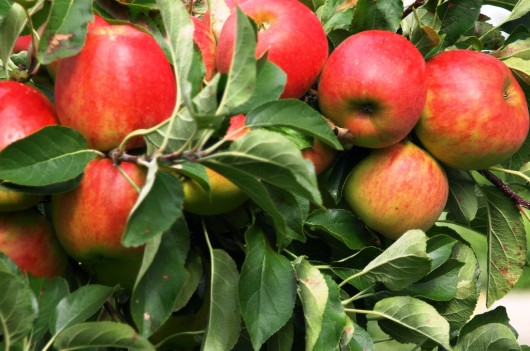Apples And Apple Juice
Apples
Apples are probably the most familiar and best-loved fruits around the world. They are enjoyed fresh, cooked in desserts and savory dishes, preserved, fermented, and as apple juice.
The earliest known source of apples is in Eastern Turkey and other areas of Mesopotamia. Alexander the Great discovered dwarf apples trees in Asia Minor and sent them back to his teacher Aristotle. Apples expanded throughout Europe and became part of mythology and folklore. They were prized for their health benefits as well as pleasing flavor. Apples are among the earliest fruits used in juices and fermented beverages.
About Apple Juice
Apple juice is made by pressing and macerating apples. The result is a cloudy liquid which can then be filtered and clarified to remove pectin and starch. Commercial apple juice is usually pasteurized and clear, and bland in taste. Locally-produced apple juice is cloudy and is often called cider. It is much tangier than filtered juice.
Apple cider in the United States is unfiltered apple juice, but in the United Kingdom it is a fermented beverage, also known as hard cider. Natural apple cider will begin to ferment after a time, which produces hard cider. Left to ferment even longer, it becomes apple cider vinegar.
Health Benefits of Apple Juice
Apples are a naturally healthy fruit, and recent research shows some promising effects from the polyphenols found in apple skins. The benefits are seen in cardiovascular heath, antioxidants, regulating blood sugar, anti-cancer (especially lung cancer), and even asthma. “An apple a day keeps the doctor away” may be an old saying, but scientists are finding that it may actually be true.
Clear, pasteurized apple juice, however, has very little of the health benefits that can be had from naturally pressed apple juice, because the valuable polyphenols, pectin, and various nutrients are in the particles that make fresh juice cloudy. Freshly pressed unprocessed apple juice has almost no loss in these beneficial elements, making it the preferred choice for health.
Making Your Own Apple Juice
Apple juice is only as good as the apples you use. Selecting a mix of several sweeter varieties will eliminate the need to add sugar to the finished juice. Mix apples with berries or other ripe fruit to make interesting combos.
It takes about 1/3 bushel of apples to make a gallon of juice. There are two ways to juice the apples: a juicing machine, and pressing or sieving. With the latter method, the apples first need to be ground up. You could probably do this with a food processor.
Simply sieving the ground apple pulp in layers of cheesecloth will result in fresh apple juice with a short shelf life. You can also refrigerate the pulp overnight and gently pour off the liquid, leaving the settled solids behind in the bottom of the container. To preserve apple juice longer, you will need to cook the pulp and use a safe canning method with sterilized jars.
More Articles On Apples, Their Health Benefits and Making Apple Juice

Apple Nutrition Facts – Why an Apple a Day Keeps the Doctor Away
What everyone knows about apples is that they are a …Apple Juice Side Effects: Is there such a thing as too much apple juice?
Most of us love apple juice and can take plenty …
The Health Benefits of Apple Juice
It’s hard to find a fruit in nature that’s healthier …A Common Apple Juice Recipe
This is one of the recipes that are easy to …The Best Apples for Making Apple Juice
Apple Juice There is rarely a drink more refreshing that …A Closer Look at the Apple: Its History, Traditional Uses & Interesting Facts
Let’s not begin this article with the everyday cliché that …
How To Grow Apples At Home
If you really want to make a 100% your own …
